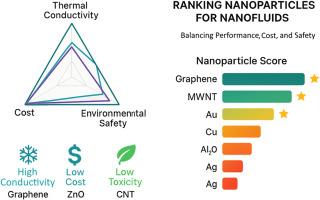Nanofluids for advanced thermal management: A multi-criteria review of performance, cost, and environmental impacts
引用次数: 0
Abstract
Nanofluids—engineered suspensions of nanoparticles in conventional fluids—have emerged as next-generation coolants due to their exceptional thermal properties. This review synthesizes recent progress in nanofluid research with a multi-criteria evaluation of thermophysical performance, cost-efficiency, and environmental impacts. Carbon-based nanofluids, particularly graphene and multi-walled carbon nanotubes (MWCNTs), dominate current research (36 %) owing to their ultrahigh thermal conductivities (∼4000–6000 W/m·K) and favorable dispersion stability. In contrast, metal-based (28 %) and metal oxide-based (24 %) nanofluids offer a trade-off between performance and affordability, with Al2O3 (44 %) emerging as the most studied oxide. Hybrid nanofluids, although representing only 12 % of studies, demonstrate synergistic thermal enhancements—boosting thermal conductivity up to 42.7 % and reducing peak battery temperatures by as much as 26.4 % in advanced battery thermal management systems. Despite their performance gains, nanofluids face economic and operational challenges. Costs range widely—from $180 for 4L of 2 % Al2O3 nanofluid to $85,000 for gold-based formulations. Viscosity models show that even small increases in nanoparticle concentration significantly elevate flow resistance, demanding greater pumping power. Environmental concerns remain significant, as certain nanoparticles commonly used in thermal applications—such as Al2O3 and Ni—have extremely low reference dose thresholds (e.g., <0.01 mg/kg/day), indicating that even minimal exposure could pose toxicological risks to human health and the environment. A nanoparticle scoring framework integrating thermal performance, cost, and environmental impact identifies graphene and low-grade MWCNTs as optimal additives. This review concludes that while nanofluids hold transformative potential for energy, electronics, and transportation sectors, further efforts are required to enhance their economic viability, environmental safety, and long-term stability for widespread industrial adoption.

纳米流体用于先进的热管理:性能、成本和环境影响的多标准审查
纳米流体是在常规流体中加入纳米颗粒的工程悬浮液,由于其特殊的热性能,已经成为下一代冷却剂。本文综述了纳米流体在热物理性能、成本效益和环境影响等多指标评价方面的最新研究进展。碳基纳米流体,特别是石墨烯和多壁碳纳米管(MWCNTs),由于其超高的导热系数(~ 4000-6000 W/m·K)和良好的分散稳定性,主导了目前的研究(36%)。相比之下,金属基(28%)和金属氧化物基(24%)纳米流体在性能和可负担性之间进行了权衡,其中氧化铝(44%)成为研究最多的氧化物。混合纳米流体虽然只占研究的12%,但在先进的电池热管理系统中,它显示出了协同增热的效果——将导热系数提高了42.7%,将电池峰值温度降低了26.4%。尽管纳米流体的性能有所提高,但仍面临着经济和操作方面的挑战。成本相差很大,从180美元的4L 2% Al2O3纳米流体到85,000美元的黄金配方。粘度模型表明,即使纳米颗粒浓度的微小增加也会显著提高流动阻力,从而需要更大的泵送功率。环境问题仍然很重要,因为通常用于热应用的某些纳米颗粒,如Al2O3和ni,具有极低的参考剂量阈值(例如0.01 mg/kg/天),这表明即使最小的接触也可能对人类健康和环境构成毒理学风险。综合热性能、成本和环境影响的纳米颗粒评分框架确定石墨烯和低品位MWCNTs是最佳添加剂。这篇综述的结论是,虽然纳米流体在能源、电子和运输部门具有变革潜力,但需要进一步努力提高其经济可行性、环境安全性和长期稳定性,以广泛应用于工业。
本文章由计算机程序翻译,如有差异,请以英文原文为准。
求助全文
约1分钟内获得全文
求助全文

 求助内容:
求助内容: 应助结果提醒方式:
应助结果提醒方式:


